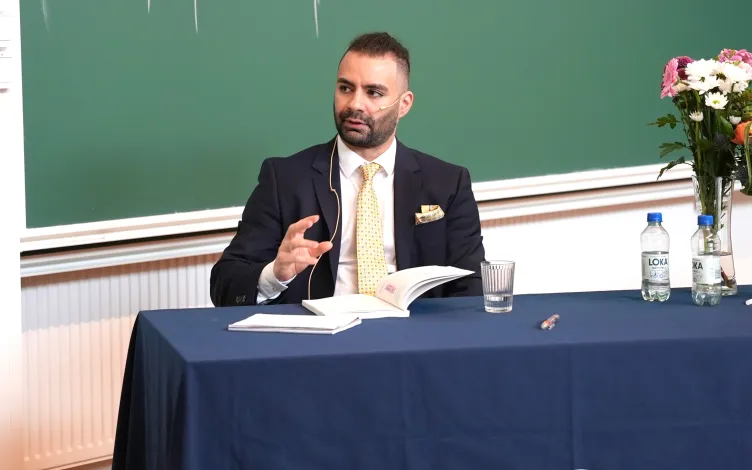
Alternative drying technologies for biologics
17 June 2024, 18:50
On 12th of June, Daniel Osanlóo, member of NextBioForm, defended his thesis "Alternative drying technologies for biologics". We decided to ask him a few questions about his research.
Could you please share some details about the focus of your research and what the results of your research mean?
My project has conducted research on alternative drying technologies for biologics. Drying of therapeutic proteins (and other biologics) are traditionally conducted by use of freeze-drying but also to some extent spray drying. I have explored vacuum foam-drying as an alternative drying technology. Moreover, I have investigated the use of matrix formers and surface competitors and their importance in preserving the stability of proteins. Finally, I have scrutinized the distribution of components at the surface and internally, upon drying.
My research has highlighted how vacuum foam-drying functions, the principal formation of a solid foam, and how formulation components can influence the establishment of a solid foam. I have also provided knowledge on the interplay between matrix formers/surface competitors and the stability benefits for proteins and also factors that contribute to the stability (and instability) of the matrix former itself. Finally, I have shown that the macromolecular components can phase separate at the surface and internally and how it was related to the function of the protein.
In what ways has your affiliation with NextBioForm contributed to both you and your research?
Drying of biologics by traditional drying techniques (such as freeze-drying but also to some extent spray drying) is well established and proven. To explore vacuum foam-drying as an alternative drying technology has been very interesting. Similar to freeze-drying, vacuum foam-drying manufactures a product constituted of pores surrounded by solid material. However, the solid material is thicker and may provide better encapsulation of larger biologics such as probiotics and perhaps even cells. The reconstitution (time until the solid material is completely dissolved) was also in competition with a freeze-dried material and may show promise for injectable protein-formulations. Hopefully the results from my project can garner continual interest to explore vacuum foam-drying as an alternative drying technology for proteins (and other biologics).
How has it been doing a PhD within NextBioForm?
Doing a PhD within the NextBioForm consortium has been very fun. Everything from events, seminars, courses, conferences has been well-planned and executed. I am glad for the opportunity and the experience that has been presented to me.
During your PhD you have had close interactions with companies, how has that been and how has it benefited for research?
It has been very giving. The consortium has provided with great collaborators and collaborations in my PhD project and in others. I am very thankful for all the collaborators in my PhD project. My primary workplace (RISE) provided the facilities and instruments throughout my PhD project. LTH contributed with knowledge and fruitful discussions about biologics. The protein I used mostly throughout my PhD project was provided by SOBI AB and was an excellent model protein of biologics. The surface competitors were provided by ENZA Biotech and Croda Nordica AB and presented very interesting features on the foam formation. Ferring Pharmaceuticals A/S provided great knowledge and helped to include what is important from a developmental standpoint. My project included supervisors from different areas (academia, research institutions, companies) and the environment was highly functional for me, as I could thrive and understand how to best use my research to increase the knowledge from a fundamental aspect and industrial perspective, respectively. For this, I am forever thankful.
Read the publication: Alternative drying technologies for biologics
2025-02-21
2025-02-21
2024-12-11
2024-12-11
2024-12-11
2024-10-24
2024-10-21
2024-10-21
2024-10-21
2024-06-17
2024-06-17
2024-06-17
2024-06-17
2024-06-17
2024-06-17
2024-04-09
2024-04-05
2024-04-05
2024-04-05
2024-04-02
2023-12-18
2023-12-04
2023-12-04
2023-12-04
2023-10-25
2023-09-27
2023-09-19
2023-09-12
2023-09-06
2023-08-15
2023-06-14
2023-06-08
2023-05-29
2023-05-16
2023-04-03
2023-03-28
2023-03-28
2023-03-28
2023-03-14
2022-11-24
2022-11-17
2022-11-17
2022-05-30
2022-05-30
2021-12-16
2021-12-14
2021-12-14
2021-12-14
2021-09-23
2021-09-02
2021-09-01
2021-05-03
2021-03-05
2021-02-26
2021-01-08
2020-12-04
2020-11-02
2020-10-26
2020-10-26
2020-10-12
2020-09-30
2020-09-23
2020-09-23
2019-12-17
2019-10-08
2019-10-04
2019-10-04
2019-10-04
2019-10-04
2019-10-04
2019-10-04